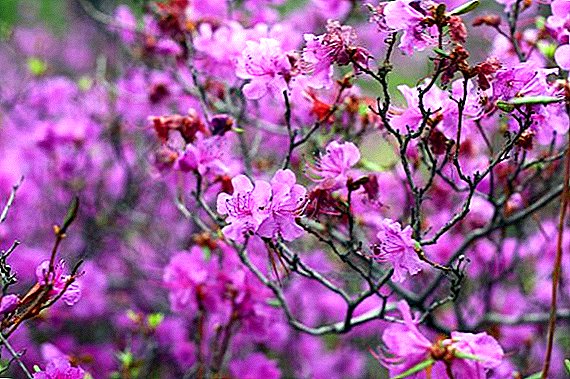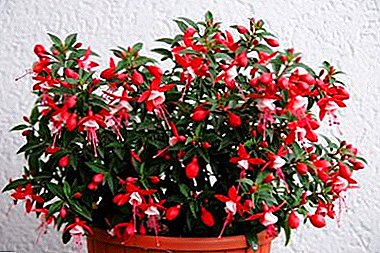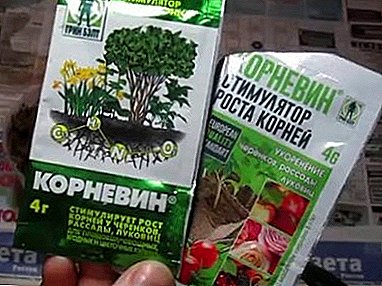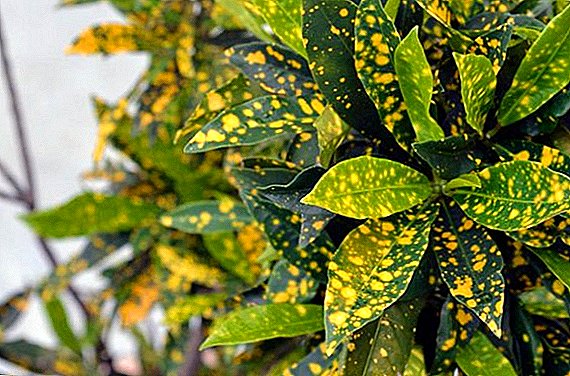
Not just begonia is called “royal” (its popular name is Rex). The plant can not only please with its beauty, but also with healing properties that stand out from the flower.
A good air filter, which is why its presence on the premises is simply necessary, especially if a person has serious chronic diseases.
The article will tell you what types of royal begonias are, how to properly care for the plant at home, as well as what diseases and pests can affect the plant.
Botanical description, history of origin, how does it bloom?
Perennial shrub with hanging shoots. Asymmetric leaves can reach 120 mm, have an elegant, but slightly oblong, surface smooth. On the one hand the plant is red, and on the other greenish with dark shades along the edges of the leaves. Coral-red flowers with a diameter of 1.5 cm are arranged only in groups, usually collected in racemes.
Flowers at the plant are same-sex. It blooms in the summer. Around 1956 in London at an auction among orchids, a new kind of flower appeared - Royal Begonia. A little later, breeders bred dozens of different varieties. Since then, the plant has developed under a variety of hybrid species. Crossed the plant with Asian species. Why royal begonia remained the progenitor of all common varieties.
Other names of indoor plants "Rex"
The classic name is Begonia Rex-hybrid or Begonia Rex Cultorum. Some of the well-known Rex begonias became known in the world several centuries ago: Begonia rex 'Abel Carriere' was bred in 1878 and can safely grow in our apartments to this day. For so long, more than a hundred varieties have appeared. Gradually, hybrids of the parent (wild-growing) species begonia rex in whose genetics did not exist at all began to be included in the Rex group, which significantly distinguished this group.
Views and their photos
Decorative

The decorative begonia has no above-ground stalks at all, and pubescent leaves instantly grow from a branched root. This type of plant is able to impress with its unusual beauty. The leaves of the begonias have different shapes and colors (read more about the ornamental hardwood begonias here). The leaves are painted in different colors:
- green;
- red;
- yellow;
- silvery;
- brown.
Hybrid variety

The royal snail begonia is a hybrid species. It has rounded leaves up to 300 mm long with small teeth at the edges. Leaf color is brown, purple, purple. They are painted with a soft green, white, silver border.
Dark mambo

The plant has olive-green pubescent leaves of oval shape, the edges are endowed with small teeth. The surface of the leaves of the metal begonia is covered with silvery pollen, resembling a metal formation.
Where and how to plant it?
Grow royal begonia should be at home, requires special care. The first thing to consider is the normal humidity of the room. It is recommended to place the pots with a plant on pallets with expanded clay or with gravel. Next to the dishes it is advised to place the dishes with water, but to install a small fountain.
It is not recommended to spray the plant - in areas where the drops fall, white spots are formed, which leads to rotting. Therefore, the dust will have to wipe with a damp cloth, and better dry.
Lighting and location
Leaving usually involves watering - frequent and abundant. It is not necessary to re-moisten the soil, as the stems and root system can rot. At the time of care should take care of the lighting in the room - the plant needs a bright and slightly diffused light, but you should not put them where direct sunlight falls.
It is better to place begonia on the windowsill from the west side. In order for the plant to develop well, then with complex care it is necessary to check the temperature indicator - it should be 18-25C. Do not put the plant near the heaters.
Soil requirements
The best mixture as a soil for the royal begonia is leaf soil, humus, peat, sand. They should be connected in a ratio of 1: 0.5: 0.5: 0.5. Drainage should be sprinkled on the bottom of the dish. After that, you can add a mixture of peat, compost, which will help replace the complex of potash-phosphate fertilizer.
Proper care
Royal begonia is considered to be a rather tender plant. Care for him at home requires the appropriate knowledge and experience.
But when caring for begonia, problems often arise:
 The plant refuses to bloom. A similar problem arises when overdosing with additional feeding, when there is a lack of light and moisture, temperature mode uncomfortable for begonias, but also in drafts.
The plant refuses to bloom. A similar problem arises when overdosing with additional feeding, when there is a lack of light and moisture, temperature mode uncomfortable for begonias, but also in drafts.- Yellow leaves. This means the plant does not have enough nutrition and moisture. Change the time of irrigation, constantly fertilize, you can try to transplant the plant in another soil. Often the yellowing of the leaves is due to the presence of pests. And here transplantation of begonias can help, but the procedure for treating the roots should be supplemented with a weak solution of potassium permanganate.
- Leaves and cuttings begin to rot. In addition to these reasons, where an important role is played by excess moisture or low absorption of fertilizer, here it is necessary to eliminate the fungus that develops in a humid environment. It should be a constant inspection, when a rot is found, you need to remove it.
We offer to watch a video about the proper care of the royal begonia
Common diseases and pests
Royal Begonia is constantly exposed to the following diseases:
- Mealy dew. Manifested in the form of white bloom. It is necessary to process with Topaz type fungicide solution.
- Gray rot. Formed on the leaves of the plant, sometimes on the stems. Spraying Bordeaux mixture will help, the use of foundation 0.2% is possible.
- Ring spots. Manifested in the form of a yellow-green spot. Formed on the tubers of the plant, why contagious begonia should be removed to another place, so as not to infect healthy ones. Carriers can be aphids and thrips, which will have to neutralize all pests.
- Bacterial spots. Formed on the lower part of the leaves in the form of watery bubbles, which turn brown and then inflorescences, cuttings. The diseased plant will have to be destroyed, healthy begonias must be treated with copper oxychloride.
- Soft false shield. It affects the entire green mass of the plant. It is formed in the form of dark sugary discharge, soot fungi may appear. The affected area of the plant instantly loses its original shape, the leaves are amazed. It should be processed garlic tincture.
- Hothouse whitefly. It usually lays eggs on the upper part of the leaves of the plant, causing discolored areas. You can remove the pest using a solution of soap.
- Gall nematode. It is presented in the form of a microscopic worm that affects the root part of the plant. On the stalks of begonias, growths are formed, where the larvae develop. The roots begin to rot, the plant stops growing after it dies. It should be watered with a solution of heterophos.
- Spider mite and aphid. May occur anywhere. Footprints should be removed. With constant care for the plant aphid is not formed. You can remove the formation of pests with a weak solution of soap. If this option does not help, then you should use onion infusion.
Breeding features
It is possible to multiply the royal begonia at home by both seeds and cuttings. Although from ordinary stalks the plant gets on beautifully.
- At the time of transplantation of begonias in spring, their reproduction occurs due to root parts.
 Cuttings should be planted in light soil and at a temperature of 24 ° C.
Cuttings should be planted in light soil and at a temperature of 24 ° C.- Rooting cuttings meanwhile cover breeding with foil for reproduction.
- It is allowed to conduct rooting in a bowl with water.
- In early summer, propagated by part of the sheet.
- It is placed on the glass.
- Divided into several parts so that the vein passes through the upper part. All these parts are pressed into the sand.
- For proper incision, you need to start from the bottom of the sheet along the large vein from the branching site.
- For a good touch with the ground, a part is pricked with a toothpick in several areas.
- The dishes are covered with foil, then they are placed in shade.
- At the same time, the room should be constantly ventilated and moistened.
- The method of propagation with the help of seeds is not always effective, since the germination rate is rather low. And only depending on the creation of conditions and proper care, the plant will live for 2-3 years. It is perfectly amenable to grafting and will continue to exist in the new plant.
Within a month, the first shoots with roots will appear. The first sprouts will be green, the royal begonia will receive bright shades only after reproduction as it matures.
We offer to watch a video about the breeding of royal begonias:
These are all the main points that a novice gardener will need to know. AND only proper care will give the plant a beautiful appearance. Royal begonia will be a real decoration in any home and can give a wonderful mood. The royal begonia is an amazingly beautiful plant that can be grown without any special problems, which is why it is tried to be planted on any parts of a private house in the summer.


 The plant refuses to bloom. A similar problem arises when overdosing with additional feeding, when there is a lack of light and moisture, temperature mode uncomfortable for begonias, but also in drafts.
The plant refuses to bloom. A similar problem arises when overdosing with additional feeding, when there is a lack of light and moisture, temperature mode uncomfortable for begonias, but also in drafts. Cuttings should be planted in light soil and at a temperature of 24 ° C.
Cuttings should be planted in light soil and at a temperature of 24 ° C.









